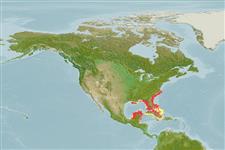Environment: milieu / climate zone / depth range / distribution range
Ecology
Marine; reef-associated; depth range 0 - 70 m (Ref. 9710). Subtropical; 36°N - 18°N, 93°W - 74°W (Ref. 55260)
Western Central Atlantic: North Carolina (USA), Bahamas and northwest Florida to Campeche Bank (Yucatan).
Size / Weight / Age
Maturity: Lm ? range ? - ? cm
Max length : 38.0 cm TL male/unsexed; (Ref. 9710)
Short description
Identification keys | Morphology | Morphometrics
Bright pattern of dark spots on the pale pectoral fins. Small mouth. Wide interorbital distance and a thick, massive head on which, in large specimens rests a small, knoblike rostrum, because the rostrum is characterized by ontogenetic allometry: very long in juveniles, very short in adults. Lateral line scale count: subopercular 7-8; cheek series usually 8 (Ref. 40824).
A rare species found on sandy, muddy, or rocky bottoms.
Life cycle and mating behavior
Maturities | Reproduction | Spawnings | Egg(s) | Fecundities | Larvae
Lieske, E. and R. Myers, 1994. Collins Pocket Guide. Coral reef fishes. Indo-Pacific & Caribbean including the Red Sea. Haper Collins Publishers, 400 p. (Ref. 9710)
IUCN Red List Status (Ref. 130435)
Threat to humans
Harmless
Human uses
Tools
Special reports
Download XML
Internet sources
Estimates based on models
Preferred temperature (Ref.
123201): 22.9 - 27.7, mean 25 °C (based on 206 cells).
Phylogenetic diversity index (Ref.
82804): PD
50 = 0.5001 [Uniqueness, from 0.5 = low to 2.0 = high].
Bayesian length-weight: a=0.02291 (0.00925 - 0.05675), b=2.94 (2.72 - 3.16), in cm total length, based on LWR estimates for this (Sub)family-body shape (Ref.
93245).
Trophic level (Ref.
69278): 3.5 ±0.6 se; based on size and trophs of closest relatives
Resilience (Ref.
120179): Low, minimum population doubling time 4.5 - 14 years (Preliminary K or Fecundity.).
Fishing Vulnerability (Ref.
59153): Low to moderate vulnerability (28 of 100).
Nutrients (Ref.
124155): Calcium = 24 [11, 60] mg/100g; Iron = 0.514 [0.267, 0.915] mg/100g; Protein = 19.5 [17.1, 22.7] %; Omega3 = 0.154 [0.057, 0.383] g/100g; Selenium = 16.3 [7.1, 38.4] μg/100g; VitaminA = 45 [11, 192] μg/100g; Zinc = 0.725 [0.438, 1.128] mg/100g (wet weight);
